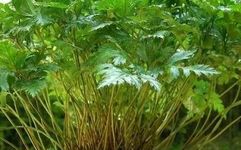Properties: Bitter taste, cold nature
Meridians: Heart; Liver; Stomach; Large Intestine (Supplement: Spleen, Kidney)
Huang Lian (Coptis chinensis) is a perennial herbaceous plant belonging to the Ranunculaceae family. Its root is used in Traditional Chinese Medicine (TCM) as Huang Lian, which has the effects of clearing heat and drying dampness, purging fire, and detoxifying. Ancient texts describe its indications as:
Clearing heat, treating eye pain and tearing, brightening the eyes, alleviating abdominal pain and diarrhea, treating swelling and pain in women’s genitalia, balancing the internal organs’ heat and cold, stopping chronic diarrhea with pus and blood, alleviating thirst, calming great fright, removing water retention, regulating the stomach and intestines, benefiting the gallbladder, and treating oral ulcers.
The saying “A mute eats Huang Lian, bitter but cannot speak” illustrates the extreme bitterness of Huang Lian, yet this does not fully convey the characteristics of the plant. What properties does Huang Lian possess, and how does it participate in healing diseases?
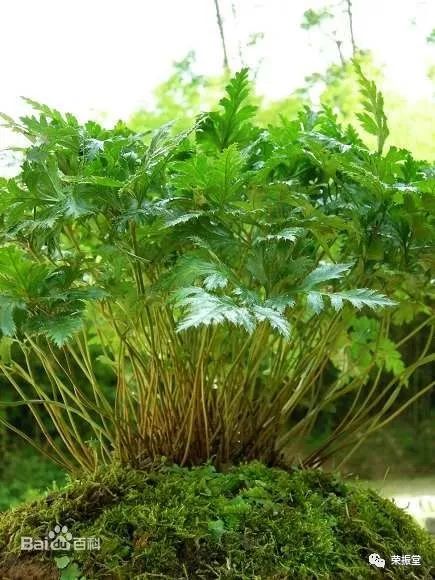
Image of wild Huang Lian, sourced from Baidu
Writing about each medicinal herb is akin to reading the life story of that plant. For TCM practitioners, knowing how to use the “medicine” effectively is crucial for achieving desired results.
If you still do not understand how Xiao Xiong analyzes Chinese herbs, please refer to the previous articles:
1. Imagination: Why can plants be used as medicine?
2. Theory: The adaptation of plants to their environment
3. Interesting Facts: The impact of harvesting time and parts on medicinal properties
4. Conclusion: The processing of Chinese medicine is like adding flowers to a brocade
 Huang Lian plant and root (origin and characteristics)
Huang Lian plant and root (origin and characteristics)

The Huang Lian plant prefers cool, moist, and shaded environments, avoiding high temperatures and drought. It requires a natural habitat with high altitude, low temperature, and high humidity. It cannot withstand strong sunlight and prefers weak light, thus needing tree shade.
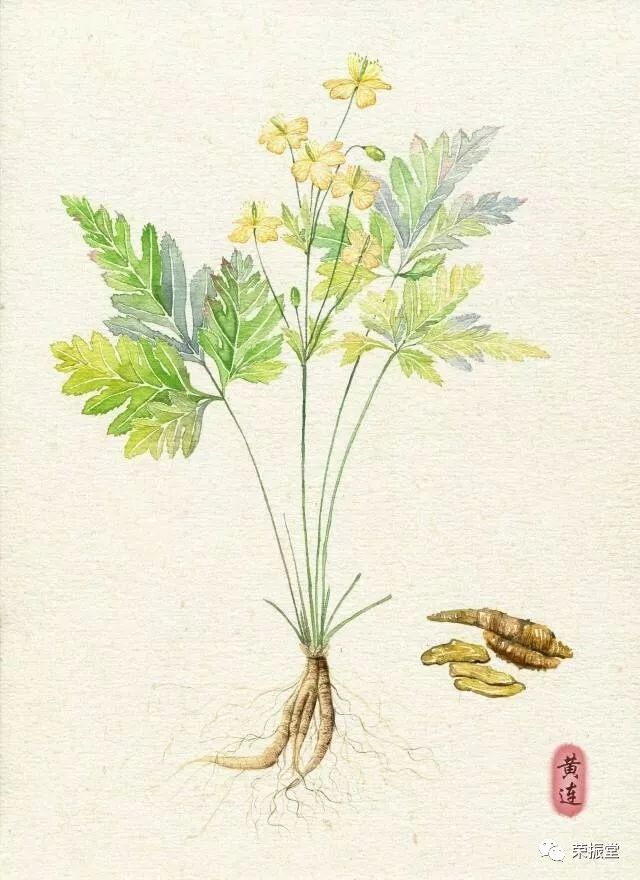
Image sourced from Baidu
The root system of Huang Lian is well-developed and shallow, distributed within a soil layer of 5-10 cm, suitable for loose, fertile topsoil rich in humus, and deep, slightly acidic soil—this relates to its regulation of the stomach meridian, which is involved in the digestion of food and water. It is mainly distributed in Sichuan, Guizhou, Hunan, Hubei, and southern Shaanxi. Because wild Huang Lian takes many years to mature, the wild herb is becoming increasingly rare, and the short-stemmed Huang Lian is currently a nationally protected plant.
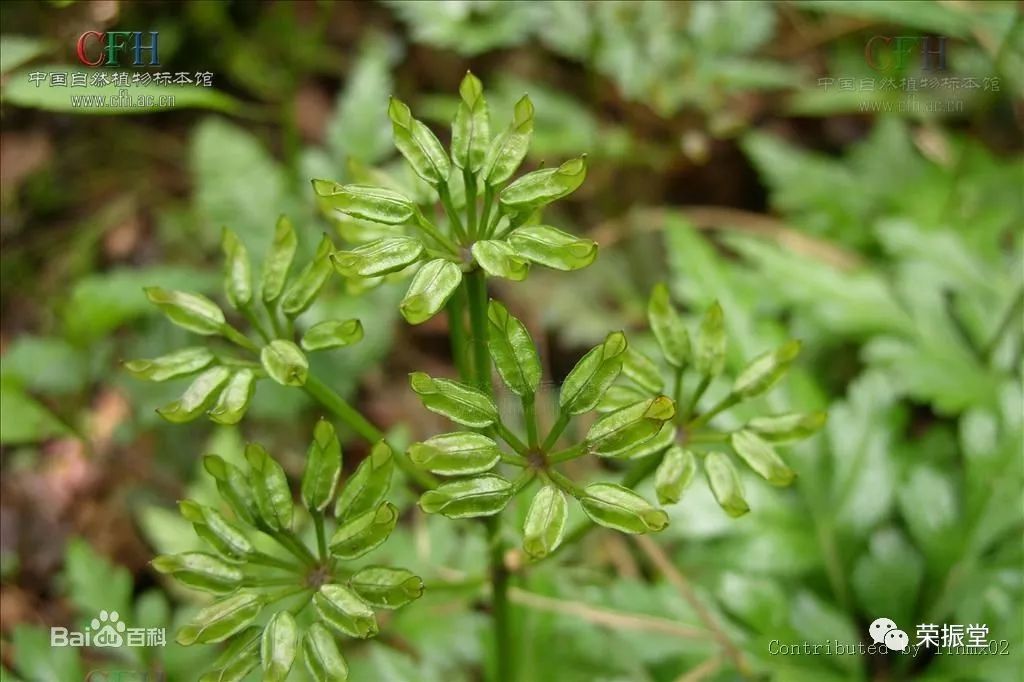
Image sourced from Baidu Encyclopedia and the National Herbarium of China
Wild Huang Lian grows in the shaded areas of cold, damp mountains at altitudes between 500 and 2000 meters. Modern cultivation aims to simulate the natural growth environment of Huang Lian, selecting soil that is deep, loose, fertile, rich in humus, well-drained, and with good permeability. The soil should be slightly acidic to neutral, and it is best to plant on gentle slopes that receive slanted light for no more than 30 degrees in the early morning and late evening. Due to the limited sunlight, the plant is not a heat-clearing and detoxifying herb; in contrast, when compared to the well-lit cultivation of Mai Dong (Ophiopogon japonicus), the dryness of Huang Lian is also considered “yang”. Huang Lian seedlings can survive winter without wilting (cold-resistant).
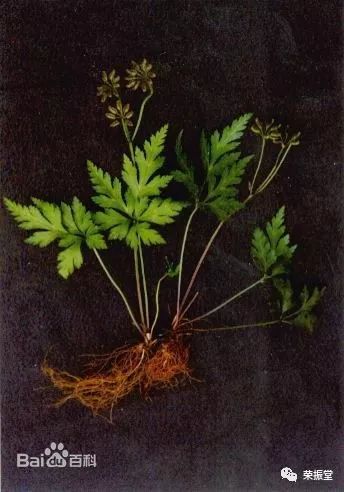
Image sourced from Baidu
Artificially cultivated Huang Lian plants are propagated from seeds. Modern cultivation simulates the natural growth environment of Huang Lian. After harvesting mature seeds in May, a shaded, flat hillside is selected, and a shade structure is built with branches, allowing rainwater to naturally enter the shelter. A pit is dug 20 cm deep to store the seeds layered with moist sand. Through the cool temperatures of early mornings and autumn, the embryos gradually develop. Between October and November, the seeds are sown in raised beds after splitting open. Then, they are covered with cow or horse manure (rich in nutrients) for winter. In late February of the following year, a low shelter is built over the beds for shading, and seedlings emerge in early March.
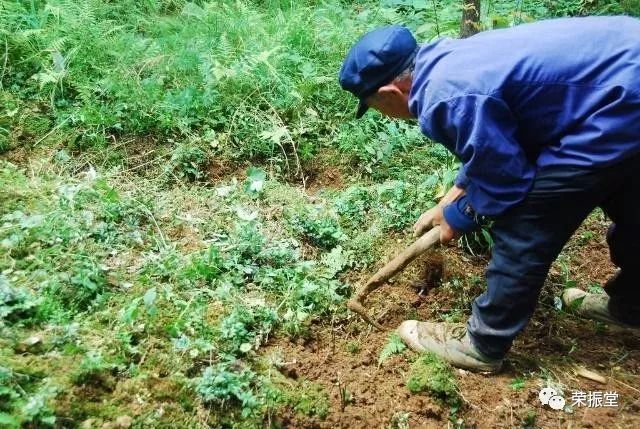
Image sourced from Baidu
The growth period of Huang Lian is about 5 years, with the best harvesting time being from September 20 to early December each year (autumn and winter harvesting, noting the difference from the summer harvesting of Fu Zi (Aconitum carmichaelii)). Harvesting 5-6 year old Huang Lian is considered top quality, with a yellow color and roots resembling fine beads connected together being the best.
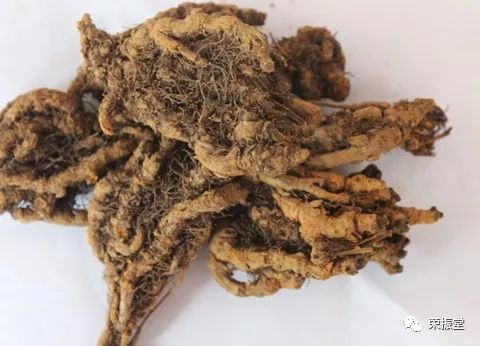
Image sourced from Baidu
 Historical evaluations by medical practitioners
Historical evaluations by medical practitioners

Note: All texts are from authoritative ancient texts on materia medica and can be verified.
Discussion on the properties of Huang Lian
From the “Leigong’s Explanation of Medicinal Properties”: Huang Lian is bitter and purges the heart, it is essential for treating heart fire diseases. Although diarrhea belongs to the spleen meridian, it is due to fire not being able to generate earth; moreover, the heart and small intestine are interrelated, so when heart fire is purged, urination is also facilitated, and the stomach and intestines become more concentrated.
From the “Newly Revised Materia Medica”: The Sichuan variety is thick and even, with an extremely bitter taste, best for treating thirst. The Jiangdong variety has nodes like beads, excellent for treating diarrhea.
From the “Shennong’s Classic of Materia Medica”: Huang Lian is extremely bitter, yet also extremely cold, thus it possesses the flavor of fire and the nature of water, capable of eliminating diseases caused by the confusion of water and fire. The confusion of water and fire refers to damp heat. Any herb that can eliminate dampness must generate heat, and any herb that can eliminate heat cannot eliminate dampness. Only Huang Lian can dry dampness with its bitterness and eliminate heat with its coldness, achieving both effects simultaneously, which is unparalleled.
From the “Bencao Mengquan”: It has a strong flavor and thin aroma, can ascend or descend, is heavy, and is yin with a slight yang.
From the “Bencao Sibian”: Huang Lian is a foot Taiyin herb… Huang Lian treats abdominal pain, which is indeed the wood draining the earth. The liver and gallbladder are interrelated; heat belongs to the gallbladder, and cold belongs to the liver. If heat does not rise, it indicates that liver yang is invading the spleen, causing abdominal pain.
From the “Bencao Chongyuan”: Generally, bitter and cold herbs are mostly of medium to low quality, yet Huang Lian is classified as a superior herb because it contains yang within yin, capable of assisting the heart fire and nourishing the spirit. The Shaoyin governs water while the heart fire is above, persisting through winter without shedding leaves.
From the “Bencao Jingjie”: Huang Lian has a cold qi, inheriting the winter cold water qi from heaven, entering the foot Shaoyin kidney meridian, with a bitter taste and no toxicity, obtaining the flavor of southern fire from the earth, entering the hand Shaoyin heart meridian.
From the “Bencao Chengya Banji”: Huang refers to its color, while Lian symbolizes its shape, enduring winter without wilting, with cold qi and bitter taste, combining the cold water qi of the sun… The bitterness ascends and the bitter nature descends, reaching the head and eyes above, and the lower parts and external sores below, while internally it governs the stomach and intestines.
Note: Throughout history, ancient scholars have had differing views on Huang Lian’s meridians and properties. The “Newly Revised Materia Medica” provides a detailed classification of Huang Lian’s thickness and node visibility, stating that the thick and even variety is best for treating thirst, while the bead-like variety is excellent for treating diarrhea. Additionally, many ancient scholars agree that the firmer Huang Lian is superior. The “Shennong’s Classic of Materia Medica” states that Huang Lian possesses the flavor of fire and the nature of water, treating damp diseases caused by the confusion of water and fire. Its ability to endure winter without wilting indicates its sufficient yang, with a bitter and concentrated taste (yang) and thin cold qi (yin), making it a consensus for treating damp heat in the middle jiao. The “Bencao Sibian” suggests that Huang Lian belongs to the spleen meridian due to its effect of purging heart fire and solidifying spleen earth, which is worth pondering.
About contraindications
From the “Leigong’s Explanation of Medicinal Properties”: Those who suffer from cold-induced diarrhea should avoid it, and those with chronic illness and qi deficiency, where heart fire is not strong… If taking this medicine, one should not eat pork; if taken for three years, one should never eat pork again.
From the “Bencao Yanyi”: If qi is full at the onset of illness, with much heat and blood diarrhea, taking it will stop the symptoms, but it is not necessary to take the full dosage. For treating diarrhea with slight blood, Huang Lian should not be used. As a bitter and drying agent, it can cause danger for the deficient, while the full should use it.
From the “Bencao Beiyao”: Those with deficiency and cold as their illness should avoid using it.
From the “Bencao Mengquan”: Avoid pork as it can lead to sperm leakage… Its efficacy is best for those with initial illness and full heat, while for those with chronic illness and qi deficiency, taking it can further aggravate the fire.
From the “Medical Introduction”: Those with yin deficiency and bleeding and those with spleen damage and blood not returning to the source should not use it.
From the “Gu Songyuan’s Medical Mirror”: It is extremely bitter and cold, but can only expel evil and clear heat; it cannot nourish the weak and support the deficient. Those with low blood and qi deficiency, and weak spleen and stomach are all in the contraindication list.
Note: Regarding contraindications, ancient sayings are very consistent—those with low qi and blood, deficiency, and cold should avoid it; it can be used during full heat and blood heat, but should be stopped when symptoms improve. Overuse can easily lead to excess heat, and those who overuse should consider the prohibition against pork (eating pork while taking Huang Lian can lead to “sperm leakage”).
About the flexible application of Huang Lian
From the “Bencao Beiyao”: For treating heart fire, use it raw; for deficient fire, stir-fry with vinegar; for liver and gallbladder fire, stir-fry with pig bile; for upper jiao fire, stir-fry with wine (for symptoms like acid reflux and nausea, or those who vomit acid, Huang Lian is suitable); for middle jiao fire, stir-fry with ginger juice; for lower jiao fire, stir-fry with salt water or children’s urine; for food accumulation fire, stir-fry with Huang Shi; for treating damp heat in the qi level, stir-fry with Wu Zhu Yu decoction (Wu Zhu Yu can lower fire and relieve stagnation), and for blood level, stir-fry with Gan Qi water.
From the “Bencao Qiuzhen”: For treating thirst, steam Huang Lian with wine; for treating summer heat, boil Huang Lian with wine; for treating lower blood, use Huang Lian with garlic; for treating liver fire, use Huang Lian with Wu Zhu Yu; for treating oral ulcers, use Huang Lian with Xi Xin; these are all cold and hot, yin and yang, mutual use of cold and heat without the harm of bias.
From the “Bencao Xinpian”: Use Huang Lian sparingly, not excessively. Although the heart belongs to fire, it must be supported by kidney water. If Huang Lian cannot resolve heat, it should not further purge fire. When fire is strong, water diminishes; when water diminishes, fire intensifies. If one treats the upper without addressing the lower, it will only increase the flames, like a pot without water, which will only burn the pot. Adding water will cause the heat to surge and boil. The treatment should focus on removing the fuel from beneath the pot, allowing it to cool naturally. Therefore, treating heart fire and causing further heat must be approached with caution, and treating heart fire should not be prioritized over nourishing kidney water. Fire fed by fire only intensifies, while fire fed by water will cease.
Note: The “Bencao Xinpian” elaborates on the reasons why prolonged and excessive use of Huang Lian can lead to excess heat. The “Bencao Beiyao” details the processing techniques that allow Huang Lian to be “applicable both upwards and downwards.” The “Bencao Qiuzhen” discusses the clever use of Huang Lian in combination with heat-clearing herbs. Clinical practitioners can refer to these insights.
Compatibility and contraindications
From the “Leigong’s Explanation of Medicinal Properties”: Huang Qin, Long Gu, Lian Qiao, and Hua Shi are compatible; avoid Ju Hua, Yuan Hua, Xuan Shen, Bai Xian, and Bai Jiang Can; avoid Kuan Dong Hua; can resolve the toxicity of Ba Dou and Wu Tou; avoid pork and cold water.
Note: Although not part of the eighteen antagonisms, attention should be paid to whether the presence of “Ju Hua, Yuan Hua, Xuan Shen, Bai Xian, and Bai Jiang Can” in the formula is compatible with Huang Lian. Additionally, Huang Lian can resolve the toxicity of Ba Dou and Wu Tou due to its strong bitterness and cold nature, which can counteract the heat properties of the two herbs. If Huang Lian is the monarch or minister in a prescription, it is advisable to remind patients to avoid pork and refrain from drinking cold water.
Summary of Huang Lian’s characteristics
-
Strong bitter taste, thin cold nature, effective in drying dampness, prefers to grow in thick earth of the middle jiao, serving as a key herb for purging and supplementing, purging heart and solidifying spleen.
-
Purging the heart and supplementing the kidney, can be paired with Gui Zhi (Cinnamon) to achieve the interaction of heart and kidney.
-
Externally it treats skin sores, internally it governs the stomach and intestines, treating the head above and the lower parts below.
-
Can resolve the toxicity of Ba Dou and Wu Tou, avoid pork and cold water.
It reminds me of the saying, “One must endure hardship to rise above others.” Daoists have a practice of taking small amounts of Huang Lian over a long period for calming the heart and assisting the interaction of heart and kidney. However, modern individuals often suffer from weakness and prefer to eat pork (considering that Huang Lian can lead to sperm leakage), so while bitterness is beneficial, it should not be overindulged.
Review:
Detailed discussion on Chinese medicine—summary of exterior-releasing and cold-dispelling herbs
Detailed discussion on Chinese medicine—summary of heat-clearing and fire-purging herbs (Gua Wei)
Detailed discussion on Chinese medicine—Huang Qin—moisture-removing and cooling air conditioning
Leaving a question for everyone, which cannot be answered in this issue (to be addressed when discussing Fu Zi): Huang Lian (Coptis) and Fu Zi (Aconitum) both belong to the Ranunculaceae family, growing at high altitudes, preferring humidity and rich soil, and having shallow roots. Why is there such a significant difference between one being cold and the other being hot?

